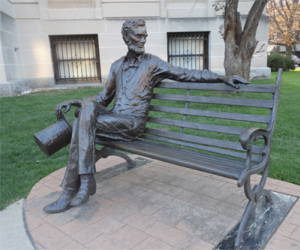Teacher Lesson Plan:
Lincoln's Bloomington

Objective:
Background:
Procedure/Suggested Activities:
- Lincoln-Douglas Debates
- Lincoln Autobiographical Sketch
- David Davis
- Election of 1860
- Civil Liberties during War Time
- Patronage
- Sarah Davis
- Lincoln's Inaugural Tour - Baltimore plot to kill Lincoln
- Letter to Grace Bedell
- Lincoln's assassination - the nation reacts
- Asahel & Mary Gridley
- Lincoln as Lawyer - "Honest Abe"
- Lincoln Recollections - Oral History
- Allen & Sarah Withers
- Copperheads: Lincoln Opposition in the North
- Emily Hanks Loomis
- Lincoln as Railsplitter
- Lincoln Recollections - Oral History
- Ezra Prince
- Lincoln in the 1850s: A Man of Consequence
- Stephen Douglas and Popular Sovereignty
Extension Activity/Discussion:
- Why is the use of Lincoln's image so effective and popular in today's culture? What does it tell us about Lincoln?
- Is the modern use of Lincoln correct? Did his actions as president or otherwise merit his various cultural interpretations?
- It is the aim of this lesson to provide an opportunity to teach aspects of Lincoln's rise to the presidency while incorporating meaningful local history within the national historical narrative of antebellum culture and politics.
Background:
- Abraham Lincoln traveled to Bloomington, Illinois on many occasions while arguing cases on the 8th Judicial Circuit Court. In this town, he met and interacted with several of its most prominent citizens during the 1840s and 1850s.
- This lesson uses biography and Bloomington citizens featured on the Cemetery Walk as a starting point of discussion for important events in teaching Abraham Lincoln's ascendency to the presidency and beyond.
- In what ways did the citizens of Bloomington help Abraham Lincoln grow as a politician?
- Is Bloomington, Illinois a significant town in Lincoln's history? Why or why not?
Procedure/Suggested Activities:
- Go to Lincoln's Bloomington Contemporaries and preview the biographies provided by the McLean County Museum of History. Each of the biographies provide some connection to Lincoln.
- Navigating to the Lincoln's Bloomington page, students can read about the speeches that Lincoln gave in Bloomington, IL.
- There are subpages to Lincoln's Bloomington that feature biographies of Bloomingtonians that had strong Lincoln connections. Each page contains links to events that the person wrote about or was directly involved in. This is a way to incorporate local history into the topics that are already a part of American History curriculum. The feature pages and their subtopics include:
- Lincoln-Douglas Debates
- Lincoln Autobiographical Sketch
- David Davis
- Election of 1860
- Civil Liberties during War Time
- Patronage
- Sarah Davis
- Lincoln's Inaugural Tour - Baltimore plot to kill Lincoln
- Letter to Grace Bedell
- Lincoln's assassination - the nation reacts
- Asahel & Mary Gridley
- Lincoln as Lawyer - "Honest Abe"
- Lincoln Recollections - Oral History
- Allen & Sarah Withers
- Copperheads: Lincoln Opposition in the North
- Emily Hanks Loomis
- Lincoln as Railsplitter
- Lincoln Recollections - Oral History
- Ezra Prince
- Lincoln in the 1850s: A Man of Consequence
- Stephen Douglas and Popular Sovereignty
Extension Activity/Discussion:
- The way America remembers and uses Abraham Lincoln's image and character is an interesting topic for classroom discussion. The Remembering Lincoln-Illinois page provides some of the recent Lincoln interpretations presented by the state of Illinois and others.
- Why is the use of Lincoln's image so effective and popular in today's culture? What does it tell us about Lincoln?
- Is the modern use of Lincoln correct? Did his actions as president or otherwise merit his various cultural interpretations?
Lincoln's Bloomington Video Resources
|
|
|
|

